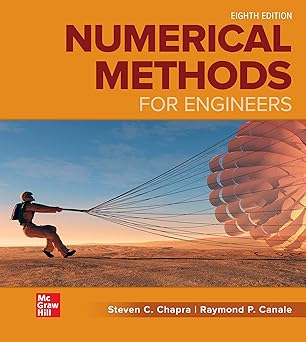Key Highlights
- •📚 Comprehensive coverage of essential numerical methods for engineers.
- •💡 Features numerous practical examples and engineering applications.
- •⭐ Highly regarded textbook, now in its trusted 8th Edition.
Description
Struggling with complex engineering problems that analytical methods just can't crack? Dive into Numerical Methods for Engineers 8th Edition by Steven Chapra! This isnt just another dense textbook; it's your practical guide to mastering the numerical techniques essential for modern enginering.
Who is this book for? It's primarily designed for undergraduate engineering students across all disciplines – mechanical, civil, electrical, chemical, you name it! Practicing engineers looking for a solid reference or a refresher on numerical methods will also find it incredibly valuable. If you need to translate mathematical models into real-world solutions, this book is definately for you.
What problem does this book solve? Many real-world engineering scenarios involve equations that are too complex or impossible to solve perfectly by hand. This book help you bridge that gap. It teaches you powerful approximation techniques (like finding roots, solving differential equations, and handling large systems of equations) so you can actually get numerical answers and solve practical design problems. It tackles the frustration of hitting a wall with theoretical math and gives you the tools to move forward.
What will you gain from reading it? You'll gain a deep understanding of fundamental numerical methods and, more importantly, learn how and when to apply them to engineering contexts. Expect to learn the theory behind the methods and see how they're implemented, potentially with examples using software like MATLAB or Python (common in newer editions). You'll build confidence in tackling complex simulations and data analysis tasks. Why is it worth reading? Chapra's book is a classic for a reason! Now in its 8th edition, it's refined, comprehensive, and known for its clear explanations and strong focus on application. The inclusion of numerous examples and problems rooted in engineering make the concepts much easier to grasp and retain. It’s a standard text in many universities worldwide, making it a reliable and well-regarded resource. Grab your PDF copy today and start solving those challenging engineering problems!
FAQ
Is this book suitable for someone new to engineering?
It's primarily aimed at undergraduate engineering students who usually have some background in calculus and basic programming, but the explanations are generally clear. It might be challenging as a very first introduction, but great for core engineering studies.
Does the 8th edition include code examples, like in MATLAB or Python?
Modern editions of Chapra's book often incorporate software applications. While we can't guarantee specifics for the PDF, the approach generally includes showing how methods are implemented, often using MATLAB, Python, or pseudocode.
What specific numerical methods are covered?
It typically covers a broad range, including root finding (bisection, Newton-Raphson), linear algebraic equations (Gauss elimination, LU decomposition), optimization, curve fitting (regression, interpolation), numerical integration and differentiation, and solving ordinary and partial differential equations (Euler's method, Runge-Kutta).
Is this book more theoretical or practical?
It strikes a good balance. It explains the underlying theory of the numerical methods but places a strong emphasis on practical application in engineering, using relevant examples and problems.
How quickly can I get the PDF after purchase?
Typically, you should recieve an email with the download link for the PDF within 1-6 hours after your payment is confirmed.
Can I use this book for self-study outside of a university course?
Absolutly! While designed as a textbook, its clear explanations and numerous examples make it suitable for self-learners or engineers wanting to brush up on their skills.
Reader Reviews
About the Author
Steven C. Chapra holds a Ph.D. in environmental engineering and is an Emeritus Professor at Tufts University. He is a renowned educator known for his expertise in numerical methods and computational modeling, particularly in environmental engineering. His textbooks are widely adopted in universities globally for their clarity and practical approach.
